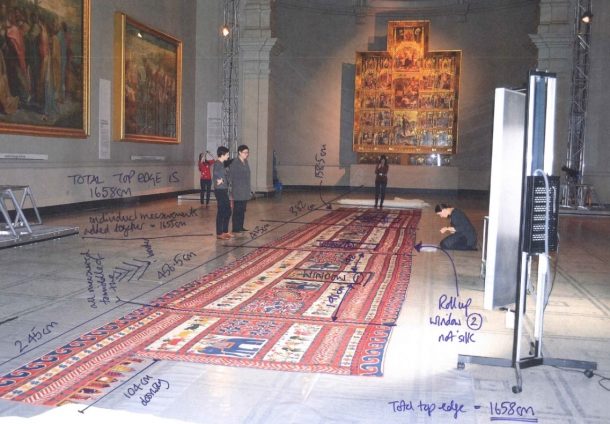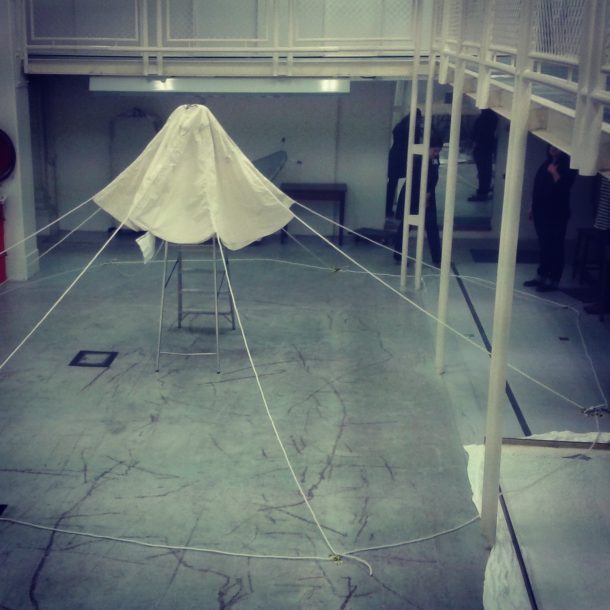Now we have an object list, the preparation of The Fabric of India exhibition can really get under way. One of the first things I need to organise is the assembly of key object information to be shared with the project team. The V&A project team is made of representatives from different departments across the museum including Security and Visitor Services, Digital and Website, Learning and Interpretation and many more. For each of these departments, understanding the objects is important to their work.
Once the objects have undergone an assessment by Conservation, we set up a number of sessions at the Clothworkers Centre, Blythe House, where we examined each object in detail, discussed and agreed the best approach for mounting and display. We also take this opportunity to double and sometimes triple check the basic object information (object size, material etc). This key object information then gets recorded into an Object List so that the Designer, Gitta Gschwendtner, can start plotting the exhibition layout. To an Exhibitions Coordinator, an object list is the holy grail of documents (we are well known in the museum for our love of spreadsheets and checklists).

Over the next few months our list will become a rainbow of coloured text and highlighted boxes that record every decision and the reason for that decision. Although this might seem a little excessive, or even obsessive, in six months time when someone asks you, ‘why can’t we display this part of an object?’ or ‘can we do this with an object?’ our list has all the answers – or at least it should do.
In order to agree how to display each object, absolutely nothing compares to seeing the objects in person. For a large proportion of objects this can be a fairly straightforward task. However, when the object is 17 meters long, as in the case of our beautiful wedding room set, just finding a space to roll out the fabric becomes a challenge.
On Monday morning, before the museum opened to the public, the team got into work early to unroll the wedding room in the enormous Raphael Gallery. As one of the largest open spaces at the V&A, the Raphael Gallery is often used to look at oversized objects and it is not uncommon to turn up and find your colleagues wanting to share this very useful space with you.

Found dumped on a New York city street and kindly donated to the museum, we have little information on how this wedding room would have been hung and how it can be displayed, which made it all the more necessary to take a good look at the object in person.
In some cases, when the object is to be loaned from another museum, undergoing conservation, or just too big, we may not be able to make a full assessment of the real objects, but we still need to get the key information: so we look at other ways to get the most accurate details. In the case of the beautiful Tipu’s tent, which we are borrowing from the National Trust, we have been able to see the sections of the tent but it will not be possible to fully erect the tent before installation. In order to understand the complexities of mounting this object the Conservation team prepared a mock-up of the roof section with calico, a ladder and some ropes. We installed this in one of our store spaces recently:

During this session we were able to discuss how the fabric might hang, what techniques could be used to put up the tent and take a measurement of the full standing height. Gitta Gschwendtner was then able to take this information and start to sketch out how this tent might work in the gallery space.

So, in the case of object preparation: size really does matter. Accurate measurements are crucial – for the Designer who has to plot the exhibition, for the technicians who make the mounts, for the conservators who prepare the objects for display – and this matters for every object whether it is a 3 centimetre piece of gold thread or a 17 meter wedding room.

Hi there!
I was wondering what your academic background is and what the usual procedure + academic requirements are for one to apply for a similar position at the V&A. I am interesting in getting into the field and any direction you can offer me would be much appreciated! Thanks!
Hi Tara,
I would suggest comparing some job specifications for academic requirements as they can vary. Volunteering and Internships in art organisations are a great way to get experience. They can also offer you the chance to works across departments which is very useful if you are still deciding which route to take.